Rice bran spoils quickly in humid conditions because the moisture activates lipolytic enzymes, which break down fats. This process leads to rancidity and off-flavors, making the bran less nutritious. High humidity also encourages mold growth and clumping, further reducing its shelf life. With ideal storage, you should keep rice bran in a cool, dry place, ideally below 60% humidity. If you expose it to higher humidity, you can expect significant quality loss in just a few days. Understanding proper storage methods can help you maintain its freshness and health benefits. Curious about those methods?
Enzymatic Activity Overview
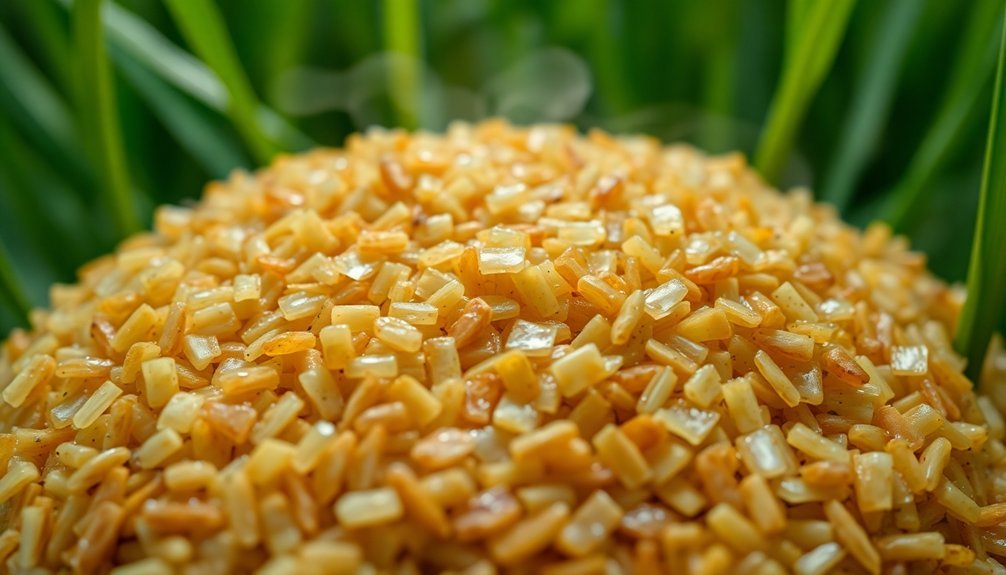
When rice bran is milled, the friction generates heat that activates lipolytic enzymes, primarily lipases, which play an essential role in the spoilage process. These enzymes quickly break down lipids into free fatty acids, leading to rapid deterioration of the oil within the bran.
You'll notice that lipase enzymes are particularly effective at hydrolyzing triglycerides, which results in hydrolytic rancidity. This enzymatic activation starts immediately after milling and can cause significant oil loss within just a few days—up to 10% in two or three days and as much as 70% after three months if left untreated. Effective stabilization methods can help mitigate this rapid spoilage and preserve the quality of the bran.
The presence of these enzymes makes rice bran highly susceptible to oxidation and browning, further contributing to spoilage. Hydrolytic rancidity not only affects the flavor and odor but also degrades valuable bioactive compounds, which limits the quality of the bran.
Additionally, the fine powdery texture, combined with enzymatic activity, complicates extraction processes. If you don't take steps to stabilize the rice bran, it can quickly become unfit for oil extraction due to this enzymatic spoilage.
Impact of Moisture Levels
Moisture levels play a pivotal role in the spoilage of rice bran, exacerbating the effects of lipolytic enzymes activated during milling.
When humidity rises, rice bran becomes a breeding ground for mold and clumping, greatly reducing its shelf life. This is particularly concerning because rice bran has a natural shelf life of about 3-9 weeks due to its high oil content, making it susceptible to spoilage in high humidity environments.
To keep your rice bran fresh, consider these key points:
- Humidity Control: Aim to maintain relative humidity levels below 60%. Higher moisture encourages hydrolytic rancidity, leading to spoilage.
- Storage Temperature: Store rice bran at lower temperatures (around 4-5°C) to slow down fat degradation and prolong freshness.
- Proper Containers: Use airtight containers to minimize moisture exposure, and consider desiccants for added protection.
Physical Structure Challenges
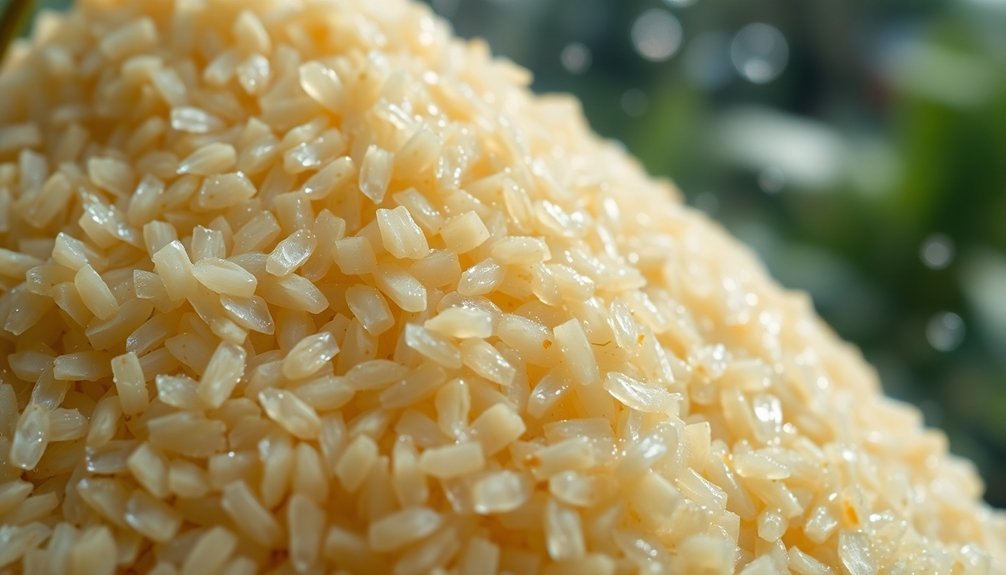
Rice bran's fine powdery texture presents significant physical structure challenges that can hinder processing efficiency. When handling this fine material, you might notice that particles tend to clump together, which can clog extraction baskets. This clumping not only slows down the extraction process but also complicates the clarification of the oil afterward.
Additionally, the small particle size increases the likelihood of equipment blockages, making uniformity in particle size vital for effective solvent extraction. Mechanical actions during milling disrupt rice bran's cellular structure, causing lipases to disperse. This dispersion accelerates hydrolysis, leading to rancidity if not promptly stabilized. Furthermore, the non-uniformity of particles can result in inconsistent oil quality, further complicating your processing efforts.
To address these challenges, compaction and gelatinization of the fine particles become necessary. By using methods like the Solvex Expander, you can compact bran into porous collets, enhancing extraction efficiency. This compaction also allows you to store the material for extended periods without deterioration, improving overall handling and processing effectiveness. Ultimately, understanding these physical structure challenges is essential for maintaining rice bran quality and efficiency in extraction, as the oil content in rice bran can significantly impact its stability and shelf life.
Key Stabilization Methods
To maintain the quality of rice bran and prevent spoilage, various stabilization methods are essential. Here are three key techniques you should consider:
- Heat Treatment: Methods like dry heat treatment and autoclave heating effectively deactivate lipase enzymes, reducing free fatty acid levels and preventing rancidity.
- Moisture Control: Utilizing high-pressure environments or steam can raise moisture levels to deactivate enzymes effectively. Maintaining humidity below 60% helps inhibit mold growth.
- Chemical Stabilization: You can apply specific chemicals to inhibit enzymatic reactions, which can be combined with other methods for enhanced stability.
Implementing these stabilization techniques can markedly extend the shelf life of rice bran, ensuring its nutritional value remains intact.
For instance, autoclave heating reduces free fatty acid content to as low as 0.41%, while infrared stabilization keeps it below 5% for up to 165 days.
Additionally, vacuum sealing can remove air, further preventing oxidation.
Ideal Storage Conditions
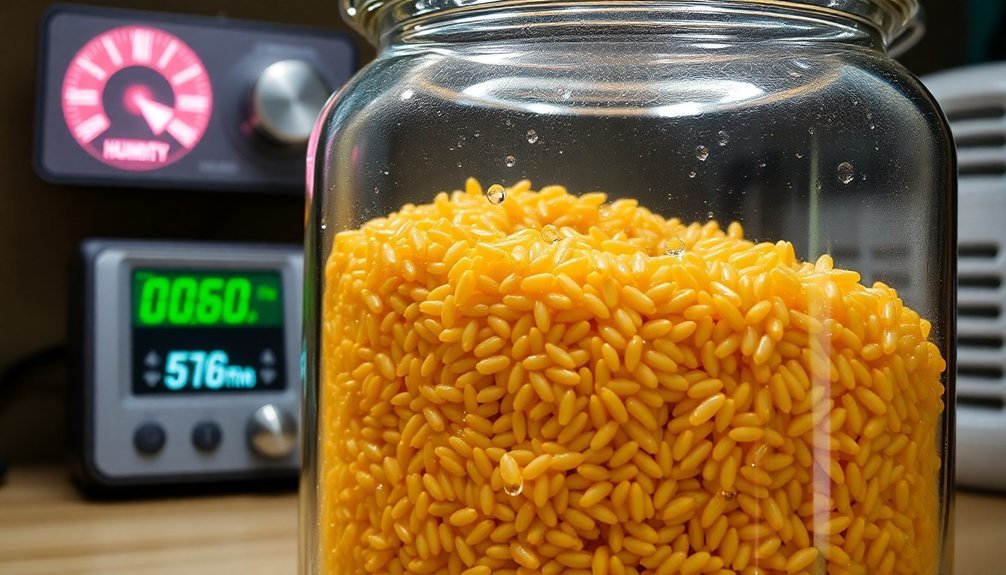
Maintaining ideal storage conditions is essential for preserving the quality of rice bran. To keep it fresh, store your rice bran in temperatures between 50°F to 70°F (10°C to 21°C). Avoid locations with temperature fluctuations or excessive heat, as these can lead to lipid oxidation and spoilage.
If you want to extend its shelf life, consider refrigeration at 4-5°C (39-41°F) or freezing it below 0°C (32°F), which can preserve quality for up to a year.
Controlling moisture is equally important. Keep relative humidity levels below 60% to prevent mold growth and clumping. You might want to use desiccants or moisture-absorbing packets in your storage areas. Always check for signs of moisture condensation before and after storage.
Using airtight containers like glass jars or food-grade plastic guarantees protection from moisture, pests, and oxidation. Make certain these containers are clean and completely dry before use.
Store rice bran in pantries away from heat sources and guarantee good air circulation. Handle it carefully to avoid heat exposure during transportation, regularly monitoring your storage area for consistent temperature and humidity levels.
Effects of Humidity on Shelf Life
Humidity can make or break the shelf life of rice bran. When you store rice bran in a humid environment, you're inviting a host of detrimental effects that can spoil your product quickly.
Here are three major impacts of high humidity:
- Mold and Fungal Growth: High humidity accelerates mold and fungi, compromising both safety and quality. Mycotoxins from these fungi can be harmful to your health.
- Texture and Appearance Changes: Excess moisture disrupts the natural balance, making rice bran soggy and altering its texture. This can lead to unwanted crystallization in sugar components, affecting the overall sensory experience.
- Shelf Life Reduction: The increased moisture not only speeds up spoilage but also degrades nutritional value and flavor. Enzymatic browning and rapid microbial growth further diminish the shelf life.
To keep your rice bran fresh, it's vital to store it in a controlled environment with low humidity.
Proper moisture-proof packaging is essential to protect against spoilage and maintain quality. By managing humidity levels, you can greatly extend the shelf life of your rice bran.
Nutritional Changes During Spoilage
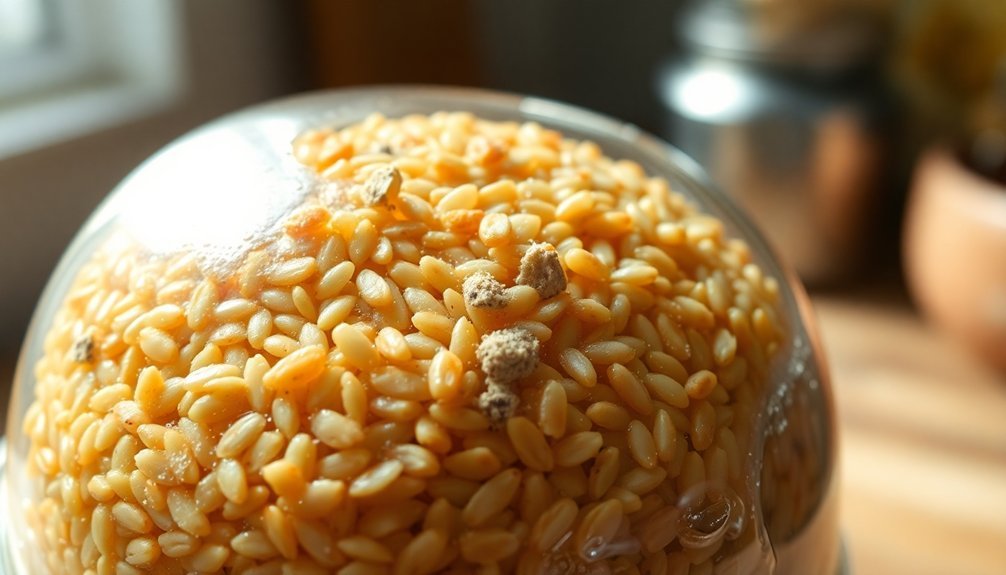
As rice bran spoils, you'll notice significant lipid degradation that impacts its overall nutritional value.
This process not only decreases antioxidant levels but also alters nutrient bioavailability, making it less beneficial for your diet.
Understanding these changes is essential for ensuring you're getting the maximum health benefits from rice bran.
Lipid Degradation Effects
During spoilage, lipid degradation in rice bran greatly impacts its nutritional value. When you store rice bran in humid conditions, lipases become highly active, causing triglycerols to break down into free fatty acids (FFA). This rapid hydrolysis can lead to significant changes in the bran's composition, and here's how it affects your nutrition:
- Increased Acidity: The breakdown produces off-flavors and a soapy taste, making the bran unpalatable.
- Unsaturated Fatty Acid Loss: Unsaturated fatty acids are especially prone to oxidation, further compromising the nutritional quality.
- Reduced Nutritional Value: The rapid conversion of lipids into FFA diminishes the health benefits associated with rice bran's protein, fiber, and essential minerals.
As a result, not only does the bran become unsuitable for consumption, but it also loses its valuable nutrients.
Stabilization methods are essential to preserve its quality. Without proper storage conditions, high humidity can lead to a rapid increase in FFA content, making it a poor choice for healthy diets.
Understanding these lipid degradation effects can help you make better choices when it comes to storing rice bran.
Antioxidant Levels Decrease
The degradation of lipids in rice bran doesn't just affect its flavor and nutritional content; it also leads to a considerable decrease in antioxidant levels. You might not realize, but these antioxidants are essential for maintaining the health benefits of rice bran. As humidity increases, enzymatic activity accelerates, particularly from lipase and lipoxygenase. This acceleration results in the breakdown of triglycerols and unsaturated fatty acids, which can drastically reduce antioxidant stability.
Here's a quick overview of key antioxidants and their vulnerability:
| Antioxidant | Vulnerability |
|---|---|
| γ-Oryzanol | Sensitive to oxidative rancidity |
| Tocopherols | Degrade considerably at high temps |
| Tocotrienols | Affected by enzymatic activity |
| Flavonoids & Phenolics | Stability compromised in humid conditions |
Inadequate storage methods can exacerbate these effects. To maintain antioxidant levels, consider proper storage techniques and stabilization methods immediately after milling. The goal should be to mitigate spoilage, and therefore preserving the health-promoting properties of rice bran for longer periods.
Nutrient Bioavailability Changes
Nutrient bioavailability in rice bran changes considerably as spoilage progresses, impacting its overall nutritional value. As the rice bran spoils, you might notice significant alterations in key nutrients. Here are three main changes to keep in mind:
- Protein Integrity: While heat treatments don't drastically alter overall protein content, they can reduce the bioavailability of essential amino acids like lysine, affecting your protein intake.
- Fatty Acids: Hydrolytic rancidity increases free fatty acid content, which can lead to off-flavors and odors. Without stabilization, FFA levels can skyrocket from 2.14% to 19.81%, diminishing the quality of fats in your diet.
- Mineral Absorption: Although stabilization techniques generally preserve mineral content, spoilage may affect the bioavailability of some minerals due to changes in phytic acid levels. This can impact how well your body absorbs essential minerals like iron and calcium.
Understanding these nutrient bioavailability changes helps you make informed decisions about consuming rice bran, especially as it ages.
To maximize nutritional benefits, proper storage and stabilization methods are essential.
Importance of Proper Stabilization
When it comes to stabilizing rice bran, employing effective enzyme inactivation techniques is essential for preventing rancidity.
You'll also need to manage moisture levels carefully to guarantee ideal heat transfer during stabilization.
Together, these strategies can greatly enhance the quality and shelf life of your rice bran.
Enzyme Inactivation Techniques
Proper stabilization of rice bran is essential to extending its shelf life and preserving its nutritional value. The activation of lipase enzymes during milling leads to rapid spoilage, breaking down triglycerides and releasing free fatty acids.
To combat this, you can utilize various enzyme inactivation techniques:
- Antilipase Enzymes: Using enzymes like papain and bromelin effectively inactivate lipase in a hydrated environment, completing the process in just minutes with a water-to-rice bran ratio of 5:1.
- Heat Treatments: High-temperature methods, such as steaming at 130°C for 2 minutes or hot air heating at 150°C for 10 minutes, inhibit lipase activity, ensuring the bran remains stable for longer periods.
- Mechanical Methods: The Solvex™ Expander applies high pressure and temperature, alongside steam and water, to deactivate enzymes while transforming rice bran into compacted collets, considerably enhancing its storage life.
Moisture Management Strategies
Effective moisture management is essential for maintaining the quality and shelf life of rice bran. High moisture content accelerates spoilage and rancidity, making it important to reduce moisture levels as soon as possible. Freshly milled rice bran typically has high moisture, which invites microbial growth and promotes enzyme activity that breaks down oils.
To counteract this, consider using infrared (IR) heating to quickly bring moisture levels down to stable levels, around 13.8%. Hot air drying is another option, though it may take longer. Ambient air drying and microwave heating can also be effective if managed properly.
Once dried, storage conditions play an important role in maintaining stability. Store rice bran in cool temperatures, around 4-5 °C, and use zipper-top bags or vacuum packaging to keep moisture levels low. Controlled humidity settings, ideally around 65% relative humidity, will help prevent moisture absorption.
Finally, process the bran immediately after milling to avoid deterioration. Proper handling is essential to prevent re-moistening, ensuring your rice bran remains fresh and stable for as long as possible.
Long-Term Preservation Strategies

To guarantee the long-term preservation of rice bran, you need to implement several strategic measures. Here are three key strategies to take into account:
1. Optimal Storage Conditions: Store rice bran in a cool, dry place, ideally between 50°F to 70°F (10°C to 21°C).
Keep relative humidity below 60% to avoid mold and clumping. A pantry or cupboard away from heat sources works best.
2. Use Airtight Containers****: Protect the quality of your rice bran by using airtight containers.
Glass jars, food-grade plastic containers, or buckets with gamma seal lids are excellent choices. Think about vacuum-sealing smaller portions to prevent oxidation and extend shelf life.
3. Refrigeration and Freezing: For longer preservation, refrigerate rice bran in airtight containers to keep it fresh for several months.
If you want to store it for up to a year, freeze it in freezer-safe bags or containers, removing as much air as possible to avoid freezer burn.
Frequently Asked Questions
How Does Humidity Affect the Flavor of Rice Bran Oil?
Humidity can negatively impact rice bran oil's flavor by promoting oxidation and hydrolysis. You might notice off-flavors or bitterness developing due to moisture absorption and rancidity, making it essential to store the oil properly.
Can Rice Bran Spoil Faster in Warm Climates?
Yes, rice bran can spoil faster in warm climates. The combination of high heat and humidity promotes mold growth and rancidity, so you should store it in cool, dry places to extend its shelf life.
What Are the Signs of Spoiled Rice Bran?
You'll notice spoiled rice bran by its rancid smell, off-flavors, and increased free fatty acids. If it tastes soapy or has a strange odor, it's best to discard it to avoid health risks.
Does Cooking With Humid Rice Bran Affect Health?
Cooking with humid rice bran can negatively affect your health. It may reduce beneficial nutrients and introduce harmful compounds, leading to gastrointestinal issues. Always use fresh, properly stored rice bran to maximize its health benefits.
How Does Humidity Influence the Aroma of Rice Bran?
Humidity considerably influences the aroma of rice bran. When moisture levels rise, undesirable odors emerge due to enzymatic activity, masking the pleasant cereal-like and nut-like aromas, making proper stabilization essential for maintaining quality.
In Summary
To summarize, rice bran spoils quickly in humid conditions due to increased enzymatic activity and the challenges posed by its physical structure. By understanding the impact of moisture, you can take steps to store rice bran properly, ensuring its freshness and nutritional value. Implementing effective stabilization methods and maintaining ideal storage conditions will help extend its shelf life. Remember, proper care can make all the difference in preserving this nutritious ingredient for your meals.

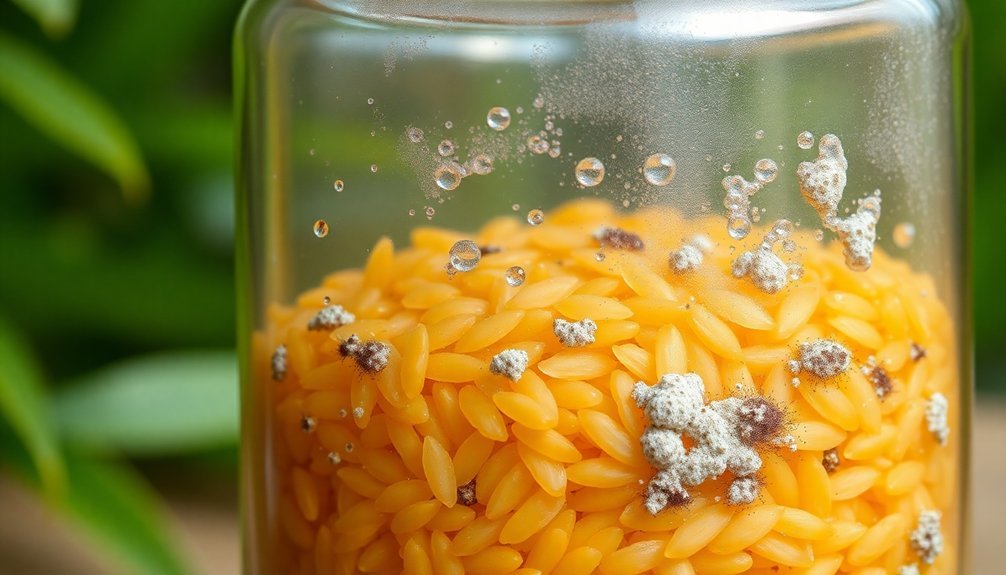



Leave a Reply